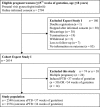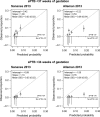Prediction models for the risk of spontaneous preterm birth based on maternal characteristics: a systematic review and independent external validation
- PMID: 29663314
- PMCID: PMC6099449
- DOI: 10.1111/aogs.13358
Prediction models for the risk of spontaneous preterm birth based on maternal characteristics: a systematic review and independent external validation
Abstract
Introduction: Prediction models may contribute to personalized risk-based management of women at high risk of spontaneous preterm delivery. Although prediction models are published frequently, often with promising results, external validation generally is lacking. We performed a systematic review of prediction models for the risk of spontaneous preterm birth based on routine clinical parameters. Additionally, we externally validated and evaluated the clinical potential of the models.
Material and methods: Prediction models based on routinely collected maternal parameters obtainable during first 16 weeks of gestation were eligible for selection. Risk of bias was assessed according to the CHARMS guidelines. We validated the selected models in a Dutch multicenter prospective cohort study comprising 2614 unselected pregnant women. Information on predictors was obtained by a web-based questionnaire. Predictive performance of the models was quantified by the area under the receiver operating characteristic curve (AUC) and calibration plots for the outcomes spontaneous preterm birth <37 weeks and <34 weeks of gestation. Clinical value was evaluated by means of decision curve analysis and calculating classification accuracy for different risk thresholds.
Results: Four studies describing five prediction models fulfilled the eligibility criteria. Risk of bias assessment revealed a moderate to high risk of bias in three studies. The AUC of the models ranged from 0.54 to 0.67 and from 0.56 to 0.70 for the outcomes spontaneous preterm birth <37 weeks and <34 weeks of gestation, respectively. A subanalysis showed that the models discriminated poorly (AUC 0.51-0.56) for nulliparous women. Although we recalibrated the models, two models retained evidence of overfitting. The decision curve analysis showed low clinical benefit for the best performing models.
Conclusions: This review revealed several reporting and methodological shortcomings of published prediction models for spontaneous preterm birth. Our external validation study indicated that none of the models had the ability to predict spontaneous preterm birth adequately in our population. Further improvement of prediction models, using recent knowledge about both model development and potential risk factors, is necessary to provide an added value in personalized risk assessment of spontaneous preterm birth.
Keywords: Spontaneous preterm birth; decision curve analysis; external validation; prediction; risk assessment; spontaneous preterm delivery; systematic review.
© 2018 The Authors Acta Obstetricia et Gynecologica Scandinavica published by John Wiley & Sons Ltd on behalf of Nordic Federation of Societies of Obstetrics and Gynecology (NFOG).
Figures





References
-
- Euro‐Peristat Project with SCPE and EUROCAT . European Perinatal Health Report. The Health and Care of Pregnant Women and Babies in Europe in 2010. Paris: Euro‐Peristat, 2013. Available at: http://www.europeristat.com
-
- Saigal S, Doyle LW. An overview of mortality and sequelae of preterm birth from infancy to adulthood. Lancet. 2008;371:261–9. - PubMed
-
- Iams JD, Romero R, Culhane JF, Goldenberg RL. Primary, secondary, and tertiary interventions to reduce the morbidity and mortality of preterm birth. Lancet. 2008;371:164–75. - PubMed
Publication types
Grants and funding
LinkOut - more resources
Full Text Sources
Other Literature Sources

